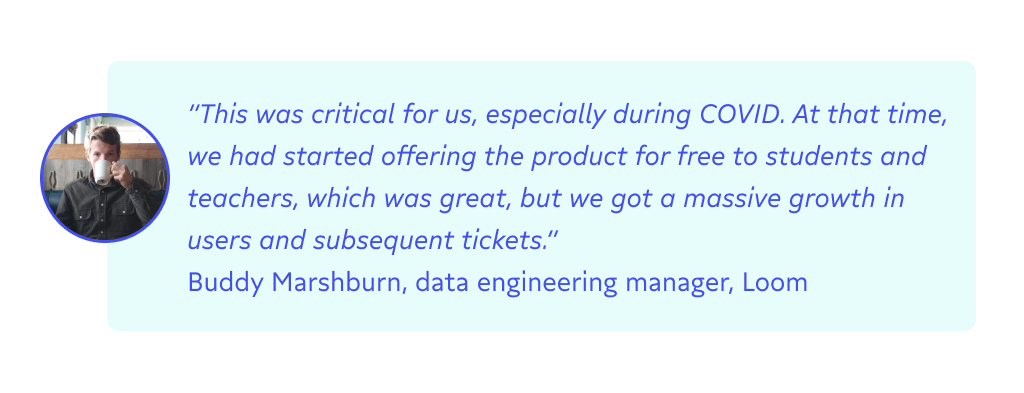This article is part of our good to great series highlighting some of the amazing things cutting-edge companies have done with reverse ETL to operationalize their data. We've also featured marketing, data, and sales team stories. 😍
Like modern data teams, customer success teams often act as a standalone business function and a direct service for other business functions simultaneously. For example, while 74% of companies have a charter that focuses customer success teams on retention, 84% also expect these teams to help with product adoption, and 47% push them to drive expansion.
Every one of these expectations requires customer success teams to have access to high-quality, real-time data. After all, the right tools can make or break customer success’s ability to make customers happy and solve questions before they become grievances.
Whether you’re struggling to gauge customer satisfaction, better prioritize your tickets, or create automatic alerts to help your team quickly respond to customer needs, reverse ETL can help.
To round out the collection of our favorite success stories: Here’s how three industry leaders—Atrium, Loom, and Bold Penguin—helped their customer success teams better support their customers with reverse ETL.
Atrium: The journey to better understanding customer satisfaction
Atrium is a B2B sales and performance software that monitors KPIs for sales teams. When they first started exploring reverse ETL, they wanted to sync data from Redshift to Salesforce to create 360-degree customer views and account health scoring.
They wanted to get a simple way to gauge customer satisfaction and were looking for a tool they could easily integrate that came out of the box with many features. Good news for Atrium: Census was both of these things (much to the delight of Co-founder and CRO Peter Kazanjy).
Peter was tasked with doing everything he could to improve customer success and sales efforts at the time. And the teams were experiencing two main pain points:
- They needed a clearer understanding of their users. In the past, Peter had used a custom-built tool called “Batman” (think stripped-back Gainsight) to do user monitoring, but it was too clunky and wouldn’t scale.
- Customers didn’t realize the full value of Atrium because it was too easy to set up (talk about a champagne problem). Users didn’t realize how much the product was doing, and Atrium needed indicators to know when (and how) to educate users to improve retention and upselling.
“We’ve also always wanted to have an easy way for sales to see which people are using Atrium successfully, for example, who is trending in the right direction, and who’s turning in the wrong direction.” Peter Kazanjy, co-founder and CRO, Atrium
Peter had heard about reverse ETL and decided to try Census out. He quickly saw it was easy to spin up and quick to add value, much like his own product. Other tools offered some similar functionality but ended up being limited in their use cases.

Suddenly, customer success teams were armed with precise information on how customers used the product, when their product usage was down, and who might need an extra hand. The reverse ETL use case for customer success went so well Peter expanded it to other teams to help the company better intervene when someone was becoming disengaged (or prompt them for an upsell if they were really enjoying all the features).
“Data just flows from Census into our Salesforce, and it gets used all throughout, both our sales motion and then also our success motion as well, and then all throughout the organization.” Peter Kazanjy, co-founder and CRO, Atrium
✅ Helped customer success gain a clearer understanding of user behavior.
✅ Replaced hard-to-use DIY tool in no time.
✅ Helped customer success and sales touch base to reiterate value at just the right time.
✅ Provided a proof of concept to help other teams adapt better data practices.
Want to learn more? Check out Atrium’s full customer story here.
Loom: The sequel to end all customer success issues
If you’ve been working through our entire collection of success stories here, you already know a bit about Loom’s use case (if you skipped ahead to the customer success section, we recommend checking out their data team story. It’s good stuff).
TL;DR: Loom is a video messaging product that wanted to send data from Snowflake to Zendesk and Intercom so their customer success team could better navigate the thousands of support tickets they were getting.
Before reverse ETL, the customer success team at Loom was left lost in a sea of tickets, unable to tell which issues were most urgent or which requests came from high-potential accounts where an extra hand could directly impact revenue.
Thankfully, Data Engineering Manager Buddy Marshburn had the customer success team in mind when he rolled out reverse ETL and dispatched it to help them make heads or tails of where to start on the pile of requests.

They decided to set up a workflow to prioritize tickets based on the user’s account type. This prioritization helped customer success reps select between accounts but didn't solve another issue: Users may belong to multiple plans.
Typically, this would mean the customer success team would have to wait for Buddy to write some SQL to create a list of all the plans a user belonged to and then map it to one value to give reps a complete picture of that user’s history.
Instead, thanks to reverse ETL, Buddy could help customer success solve a complex problem quickly and successfully conquer the sea of support tickets from users.
✅ Helped Loom respond to increased ticket volume due to COVID and broader adoption in the education industry.
✅ Gave customer success the ability to prioritize based on account type and hierarchy.
✅ Freed customer success from having to rely on the data team.
Want to learn more? Check out Loom’s full customer story here.
Bold Penguin: Heroically beating back support response times from 24 hours to 30 minutes
Bold Penguin is an insurtech company that supports commercial insurance carriers and agents via their insurance exchange to help agents match businesses with quotes. When Bold Penguin started looking for reverse ETL solutions, they wanted to sync data from Redshift to Salesforce, Intercom, and Slack for granular segmentation, email personalization, and operational Slack results.
The customer success team generally relied on the business intelligence unit to help them operate effectively within the company. But as the company grew, so did the amount of time it took for the BI team to respond to requests, making it difficult for customer success reps to get the data they needed to serve customers well.
“It was a full-time job to maintain BI jobs just to ship data to places and have it not be quite right. One of our BI analysts stumbled across Census. We decided to give it a shot and it just solved all of the pain points.” Eric Bloedorn, director of product management, Bold Penguin
Thankfully, the BI team decided to look for a tool to help them with their data bottleneck and found one that didn’t require much time to set up: Census. With the addition of reverse ETL to their data stack, the BI team could unblock themselves and help customer success be more self-serve.
Reverse ETL enabled the BI team to set up timely Slack alerts for the customer success team that let them know if a client ran into a billing failure or couldn’t validate their credentials. From there, customer success reps could quickly connect with the user and resolve the problem to restore access for users.
Before this support process used to take the support team more than 24 hours to respond, leaving users stranded without help and unable to access vital services. Now, with operational Slack messages in place, reps have cut that response time down to 30 minutes.

Plus, when new data needs arise on the customer success team, they can better self-serve. No more waiting weeks for the BI team to build a custom connection. It's a win-win-win for everyone, from the customer reps to the customers they support.
✅ Reduced response time for partner login issues from days to minutes.
✅ Let business analysts outside the BI team set up their own data connections.
✅ Automated marketing segmentation to enable targeted campaigns.
Check out Bold Penguin's full customer story here.
What’s next? Take control of your own data story with reverse ETL
We hope you’ve enjoyed learning about how great people can make a real difference to their entire organization’s operations, vision, and customers with reverse ETL. It's not just that reverse ETL lets marketing teams do more with data than ever before (that's pretty neat though). Reverse ETL lets you operationalize your data, maximize your time, drive more business value, and focus on the work that lights you and your team up.
Thinking about checking out reverse ETL tools to see what you can achieve? We have just the thing for you: our Ultimate guide to evaluating reverse ETL vendors. Grab a copy, check it out, and share it with all the great people on your team.


















